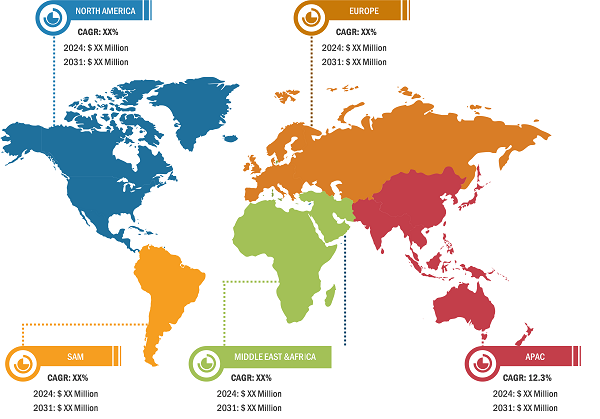Customization, Flexibility, and Smarter Warehousing Boost Vertical Lift Module Market Growth
According to our latest study titled "Vertical Lift Module Market Forecast to 2031 – Global and Regional Share, Trend, and Growth Opportunity Analysis – by Delivery Type, Storage Type, End-Use, and Geography," the market was valued at US$ 950.19 million in 2024 and is projected to reach US$ 1,766.08 million by 2031; it is estimated to register a CAGR of 9.7% from 2025 to 2031. The report includes prospects in light of current Vertical Lift Module market trends and factors influencing the market growth.
Today’s businesses are no longer satisfied with one-size-fits-all solutions for storage systems. They require systems that match their workflows, work area limitations, and inventory characteristics. VLMs meet this requirement with their modular and configurable options that permit businesses to modify tray sizes, heights, and weight limits depending on the kept items. VLMs with their high configurability and adaptability are valuable in dynamic warehouse settings where product lines, SKU volumes, or packaging types frequently alter. VLMs offer systems with high operational agility that are able to react to varying market demands with no major infrastructure modifications.
Vertical Lift Module Market – by Region, 2024 and 2031
Vertical Lift Module Market Size and Forecast (2021 - 2031), Global and Regional Share, Trend, and Growth Opportunity Analysis Report Coverage: By Delivery Type (Single and Dual Level Delivery), Storage Type (Non-Refrigerated and Refrigerated Type), End-use (Automotive, E-commerce, Semiconductor and Electronics, Metals and Machinery, Food and Beverages, and Others), and Geography 
Vertical Lift Module (VLM) Market Growth & Scope Report 2031
Download Free Sample
Source: The Insight Partners Analysis
Used in combination with the structural flexibility of VLMs, software integration is equally important from the perspective of enabling intelligent, data-driven VLM integration. These VLMs now offer deep integration with advanced control systems for their proprietary VMS, and legacy WMS and ERP solutions. This integration facilitates real-time synced inventory visibility and automated functions such as order selection and predictive stock replenishment to form cohesive, automated storage systems. Features like dynamic storage allocation and software-controlled picking enhance overall picking performance, optimizing storage efficiency by adjusting to changes in the inventory on the floor. Setting like these are crucial in precision industries such as pharmaceuticals, aerospace, and electronics, where real-time traceability, compliance, and inventory accuracy are mission critical.
VLMs are essential to developing connected, scalable, and future-ready logistics operations as businesses construct "smart warehouses" to support digital transformation initiatives. Their ability to integrate with IoT sensors, automation systems, and robotics puts them at the forefront of next-generation warehousing, and their modularity permits phased deployment, allowing businesses to start small and grow as needed. VLMs offer the perfect balance between flexibility and compliance in the aerospace and medical technology industries, where products need to be stored in a secure, traceable, and environmentally controlled manner. The market for vertical lift modules is expanding as a result of the combination of intelligent software and physical modularity, since companies see these systems as strategic assets and storage units for their digital supply chain architecture. This convergence of physical modularity and intelligent software drives vertical lift module market growth, as businesses view these systems as storage units and strategic assets in their digital supply chain architecture.
The Vertical Lift Module market analysis has been carried out by considering the following segments: delivery type, storage type, and end-use industry.
Based on delivery type, the market is bifurcated into single and dual level delivery. The dual level delivery segment held a larger Vertical Lift Module market share in 2024. By storage type, the market is segmented into non-refrigerated and refrigerated. Based on end-use, the market is categorized into automotive, e-commerce, semiconductor and electronics, metals and machinery, food and beverages, and others. The automotive segment held the largest Vertical Lift Module market share in 2024.
The geographical scope of the Vertical Lift Module market report entails North America (US, Canada, and Mexico), Europe (Spain, UK, Germany, France, Italy, and Rest of Europe), Asia Pacific (South Korea, China, India, Japan, Australia, and Rest of Asia Pacific), the Middle East & Africa (South Africa, Saudi Arabia, UAE, and Rest of Middle East & Africa), and South & Central America (Chile and Rest of South & Central America). North America accounted for the largest Vertical Lift Module market share in 2024.
The vertical lift module market growth in North America is shaped by the region's emphasis on operational efficiency, fast fulfillment, and technological innovation. With extensive use of VLMs in the e-commerce, automotive, healthcare, and aerospace industries, the US leads the world in adoption. Retailers and logistics companies are using VLMs to boost order picking speed and storage density as same-day delivery expectations and micro-fulfillment centers grow. VLMs are a good fit for the legacy warehouse infrastructure that North American businesses are updating to accommodate more ergonomic and data-driven systems. Automated vertical systems that minimize bending, climbing, and manual handling are preferred due to the strong emphasis on employee safety and compliance.
Europe is a well-established vertical lift module market driven by an established culture of industrial automation. France, Germany, and Italy have a robust manufacturing legacy in aerospace, automotive, and pharmaceutical sectors, which demand VLMs. European companies are early adopters of Industry 4.0 practices, integrating data-driven logistics and advanced automation into their operations. Sustainability regulations and increasing labor costs have encouraged companies to implement automated systems that reduce physical strain and enhance accuracy. In many facilities, VLMs are used for storage and as part of an integrated, digitized workflow that boosts productivity and safety.
SSI SCHAEFER Group, Bastian Solutions LLC, Daifuku Co Ltd, Kardex Holding AG, Mecalux SA, Modula GROUP, Autocrib Inc, Hänel Büro- und Lagersysteme, White Systems, and Weland Solutions are among the key players profiled in the Vertical Lift Module market report.
Contact Us
Phone: +1-646-491-9876
Email Id: sales@theinsightpartners.com